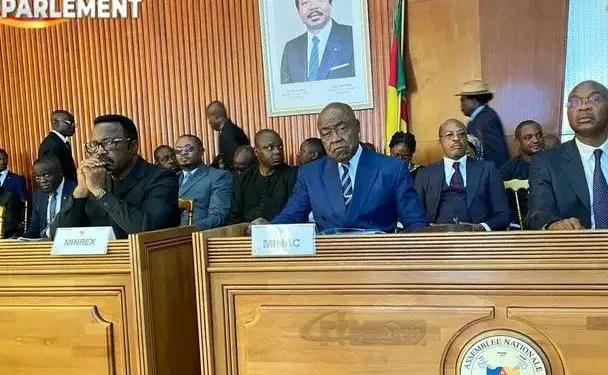As Members of Parliament engage in the crucial debates surrounding Cameroon’s 2025 budget, President Paul Biya’s portrait quietly observes from the walls of the National Assembly. This image, an unquestionable fixture in the chamber, raises the question: Why is the president’s portrait on display in a place that symbolises the legislative branch of government, an institution that, in theory, should operate independently from the executive?
In Cameroon’s presidential system, the government divides into three branches: the executive, led by the president; the legislature, represented by elected officials; and the judiciary, administered by judges. The principle of separation of powers is foundational to ensuring that no single branch dominates the others. Yet, in Cameroon, where Biya has held power for over four decades, the boundaries between these branches seem increasingly blurred.
The Executive’s Overreach
The centralization of power in the hands of the president is an issue that has long raised concerns among critics of the current regime. Biya’s influence extends far beyond the executive role granted to him by the Constitution. Not only does he control the government and military as commander-in-chief, but he also holds the title of head of the judiciary council, which severely undermines the independence of the judiciary. This consolidation of power casts serious doubts on the impartiality and autonomy of the institutions meant to act as checks on the president’s authority.
However, the placement of Biya’s picture in the National Assembly is perhaps the most blatant visual representation of his grip over the legislature. Despite being the head of the executive branch, the president’s image in the legislature—a body that theoretically holds the power to make and amend laws—suggests a level of control that exceeds mere symbolism.
A Question of Independence
Under normal democratic conditions, one would expect the three branches of government to operate with a degree of separation, each maintaining its unique role in the governance of the nation. The question then arises: Could we ever imagine the portraits of the Speaker of the National Assembly hanging in the presidency or the courts? Of course, not. In a truly independent system, such images would undermine the neutrality and sovereignty of these institutions. The presence of the president’s portrait in the National Assembly risks portraying a political dynamic where the legislature becomes a subordinate entity to the executive, even if not overtly stated.
To argue that the president’s picture belongs in the National Assembly is to ignore the basic principles of democratic governance. Yes, it is true that in some countries, the president’s portrait is placed in public buildings as a symbol of unity and national representation. However, this practice should be carefully considered in context. In Cameroon, the president has held power for 42 years. His portrait stands not just as a symbol of leadership but as a reminder of the concentration of power in the executive, overshadowing all other branches.
The Growing Concern of Power Imbalance
This overreach extends beyond symbolism. The president’s ability to appoint members of the Constitutional Council, judiciary, and key state positions without oversight from Parliament only deepens concerns. Many appointees, especially in the Ministry of Justice, do not take an oath before Parliament, which reduces the accountability that the legislature could exert. The absence of checks and balances makes the president nearly untouchable.
The Higher Judicial Council should convene every five years to oversee the judicial system, but it has not met for years. Many directors of state corporations hold positions long after their mandates expire, with some even reaching retirement age, yet they remain in power with little to no consequences. These issues reveal a systemic problem that demands attention.
In fact, when members of Parliament have attempted to question or challenge this imbalance—such as during the June session, when a senator inquired about the inaction of the Higher Judicial Council—the responses have been evasive or nonexistent. The silence on such matters only reinforces the growing perception that the president, with his portrait ever-present in the National Assembly, is beyond reproach.
The Risk to Democratic Institutions
The presence of the president’s portrait in the National Assembly is not just an issue of decorum—it is a matter of the very nature of governance in Cameroon. The executive’s image on the walls of a legislature that should act independently undermines the core principles of political neutrality and fairness. This is especially true in a context where the executive has already accumulated so much power.
Some argue that placing the president’s portrait in Parliament is a simple tradition, a sign of unity and respect for the office. In a country where one individual and his appointed cronies increasingly concentrate political power, such symbolism takes on an entirely different meaning. The president’s dominance over all institutions of the state stands out as a subtle reminder—an unfortunate message during a time when Cameroonians must focus on strengthening the independence and accountability of their democratic institutions.
A Call for Change
In a functioning democracy, the president’s picture may symbolise unity, but in Cameroon, it risks being a symbol of the consolidation of power. Questions ought to be asked about the presence of Biya’s portrait in the National Assembly. They should focus not only on aesthetic grounds but also on the larger conversation about the separation of powers, the accountability of elected officials, and the independence of the legislature.
The people of Cameroon must demand a system that divides and balances power, given the country’s precarious political future. This ensures institutions function without fear or favour, and no single individual, no matter how powerful, holds sway over every branch of government. Only then can we truly realise the meaning of democracy.



